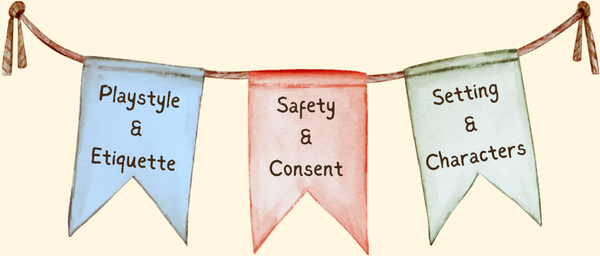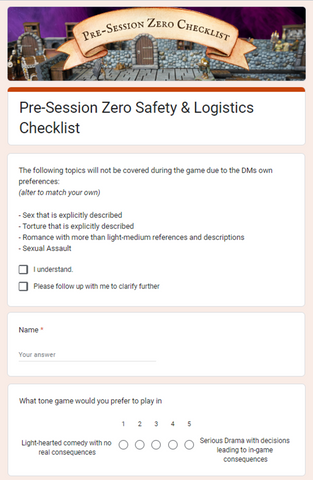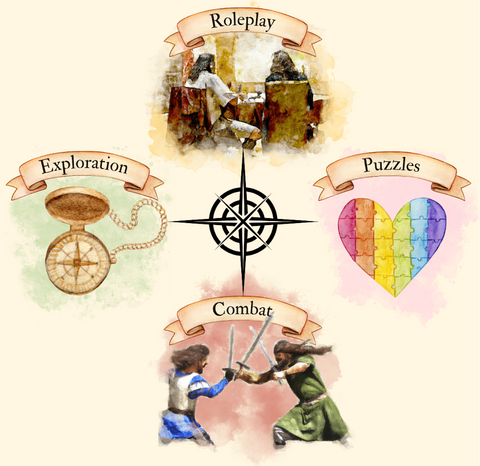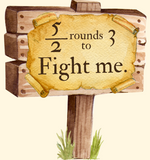What is a Session Zero and How to Run One
Posted by Annabelle Collins on
Session Zero is a dedicated session run before the campaign begins to go over ground rules and establish expectations. It's purpose is to create a space for open communication to understand each others boundaries, create characters, and build a solid foundation for your game.
Running a Session Zero can be vital for the success of a campaign, especially when DMing for a group you haven’t played with before.
I never used to run Session Zeros and now I wouldn’t start a campaign without one!

Let me guide you through the process…
How to run a successful Session Zero
The key to a good Session Zero is to have a plan for what you want to cover.
You also want to set the tone of the session right from the start. Model the atmosphere you want your campaign to have by being enthusiastic, confident, and focused on the players' needs.
I have broken down running a Session Zero into three main parts:

Before you begin though, you will need to send your players your pre-session-zero safety and consent list.
Before you begin: The RPG safety and consent checklist
The Safety and Consent checklist is a really great tool that should be used in every session zero!

I have adapted the brilliant RPG Consent Checklist by Monte Cook Games into a complete pre-session-zero checklist.
Link to make copy for personal use
Customise this form for each campaign you do, adding your own personal preferences.
Think about the adventure you want to run and consider any sensitive topics that may come up that are not already mentioned and add them to your checklist.
Send the form to your players at least a few days before the session zero to give them time to fill it in.
Once you have read through your players answers you are ready to run your Session Zero!
Part 1: Playstyle preferences and table etiquette
Begin by talking about the balance of role-playing, combat, and exploration you are aiming for in the campaign.
A table with three players heavily into the roleplay and one “murder hobo” is going to have a bumpy ride to say the least!


Setting expectations for player behavior
Establish guidelines for respectful, inclusive and enjoyable play. For example, you may have rules against raised voices, even during in-character disagreements.
You might want to set an expectation that everyone shows up on time each game, or ask them to try give a weeks notice if they can’t make the game.
Establishing house rules and table etiquette
Clarify any specific rules for the table, such as the use of electronic devices or how you will handle character death.

If having players futzing on their phones instead of paying attention to the game would hurt your feelings as a DM, let them know beforehand.
Silently stewing helps no-one but chefs!
Discussing any Homebrew Rules

I love using some homebrew rules.
These include things like rounding up damage (the mathematician in me has always hated DnD rules of rounding down) and whether you’re using the optional flanking rules.
It’s really important to make sure your players are aware of any changes you have made to avoid confusion and heartache later on!
Part 2: Safety and Consent
It’s essential to have a discussion with your players about what their tolerance levels are, and if there are triggers or topics that need to stay firmly out of the game.

For example, players with addiction trauma may need modifications to official campaign modules such as Curse of Strahd.
Make sure you’ve looked over your players answers to the Safety and Consent checklist, understood and communicated any hard boundaries to the table.
Open communication
Encourage open communication during your session zero and role model this for your players. When you talk about the rules and boundaries, check in with your players, ask their thoughts and make sure they understand.
Be sensitive to your players needs
Be aware that some of your players may not want to talk about triggers.
It's helpful to be prepared with phrases like “After reading through the answers I have come to the conclusion that racism will not be included in our game.“ that don’t point to any one person.
I recommend taking a ten minute break at this point, giving your players time to step away, process information and ask questions.
Part 3: Introducing the Setting and Making DnD Characters
Get prepared with any materials and resources you might need ready for guiding your players through the character creation process. You'll probably want to have the Players Handbook and the Campaign / Setting Guide to hand.
It really speeds things up when you have the info ready in easy reach!

Introducing the game world and setting

Provide an overview of the world for your players, emphasising any unique aspects and homebrew elements. You want to make sure everyone is on the same page and excited to play the game you’re running.
A player who’s into gritty realism and dark horror may not enjoy a whimsical game about running a magical bakery!
Character creation
This is a great time to guide players through the process of creating their character, different races and classes etc.
Help them develop a backstory with hooks that tie them into the adventure.
I recommend encouraging your players to talk to each other and work together in creating character connections and shared backstories.

They don’t all have to be connected, but a few player character connections can really help with roleplay and breaking the ice at the start of the game.
Speaking of…
Icebreaker Roleplay
If you can, finish with a short (15-30 minute) roleplay session of the characters first meeting as a prologue to the campaign.
This can help your players feel comfortable with their characters and with each other before you even start your first session.
Post-Session Zero: Setting the Stage for Session One
At the end of your Session Zero recap the key takeaways to your players.
Ideally, you want a written document like a notion page or google doc that you and your players can look back on to refresh your memories 20 weeks down the line.
Summarize the important points discussed during Session Zero, including agreed etiquette, character connections, campaign themes and topics that are “off the table”.
It can be really helpful both for you as DM and for them as players!

In Conclusion
Running a good Session Zero is a vital step in creating a successful and enjoyable tabletop role-playing campaign, whether it’s DnD or something else entirely.
Having everyone on the same page with clear expectations makes a huge difference, setting you up for success further down the line. It makes it easier for everyone, but you most of all!
Don’t miss this step when starting up a game! Get prepared and set yourself up for a fantastic, collaborative game that everyone at the table will love!


Hi! I'm Annabelle! I'm the author of this blog and a huge nerd!
I also make magnetic, double-sided, modular dungeon tiles!
My DnD terrain contains secret spinning magnets so that each piece snaps instantly to every other. They even come in a box disguised as a spellbook to store away on your bookshelf!
They're really cool, you should totally check them out here!
Share this post
- 3 comments
- Tags: Blog, Dungeon Master Tips


Thank you so much for the great information! Definitely added to my plan for my very first DM campaign. I have to say my favorite part on this information is the Google sheet for consent. I was wondering if folks did that, and you even provided you! Thank you for helping us newbies learn!
Hey thanks so much! That really means a lot to me :) I am really glad that you find this helpful as a new DM! It’s always so wonderful to see more people getting started with the game and to see new DM’s stretch their wings!
Thanks for the comment! I only just saw it now but it really made my day! :D
Just discovered this website, this is the first article I’ve read, love it! I am going to attempt to start being a DM, hopefully this is a good aid for me and my group, thank you!